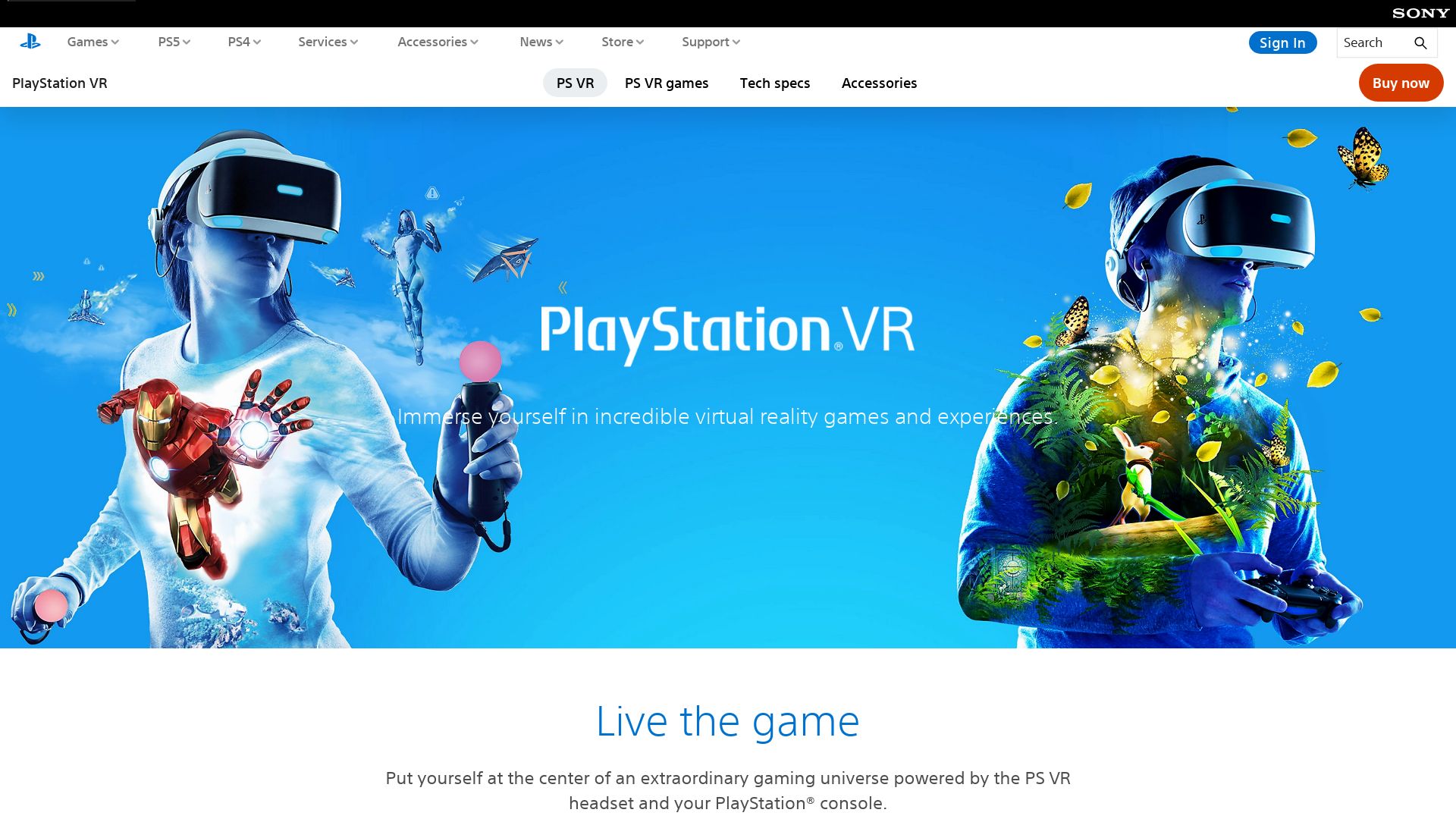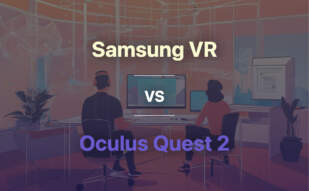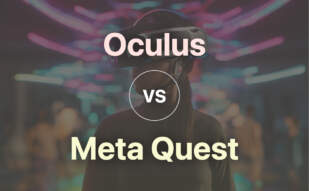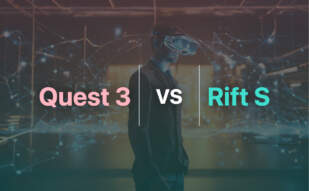Oculus Go developed by Meta Reality Labs, Qualcomm, Xiaomi is a standalone virtual reality headset introduced in October 2017. It features non-positional 3-degrees-of-freedom (3DOF) tracking, comfortable faceplate material with foam and knit mesh, and lightweight design. With a Qualcomm Snapdragon 821 chipset, 5.5-inch LCD display, and Android 7.0 OS, it offers an affordable and user-friendly VR experience.
For those exploring options beyond Oculus Go, alternatives encompass Quest 2, Gear VR, Oculus, PSVR, and DK1.

Quest 2
An unparalleled powerhouse in the world of Virtual Reality, the Meta Quest 2– developed by Reality Labs, part of Meta Platforms- is a VR headset rewriting the limits of immersive experiences. Unveiled to the world on October 13, 2020, this revolutionizing device navigates a maverick’s journey from the Oculus Quest 2 to the Meta Quest 2 since the Meta transition in 2022.
Quest 2 Top Features
- Powered by an invincible Qualcomm SnapDragon XR2 processor and an Android-based Quest system software, currently in its 12.1 version.
- Equipped with a high-definition RGB LCD display offering an impressive resolution of 1832 x 1920 per eye and refresh rates soaring from 72 to 120 Hz for an improved, nuanced visual journey.
- A memory of 6 GB LPDDR4X paired with internal storage options spanning to 64 GB, 128 GB, and 256 GB.
- Pioneers in adopting a 6DoF inside-out tracking via four in-built cameras and two controllers, offering an immersive VR experience.
| Weight | Design | Connectivity |
|---|---|---|
| A light featherweight design tipping the scales at just 503g (17.7 oz). | Sporting an elegant and convenient design featuring up-to-date specs, a refreshingly elevated per-eye resolution, and Oculus Touch controllers promising prolonged battery life. | Ensures seamless connections via USB-C, Bluetooth 5, and Wi-Fi 6. |
Quest 2 Limitations
- An unyielding battery life sticking at a span of 2-3 hours between charges.
- Although the original storage offering has expanded to a standard 128GB, users are left with no room for expansion.
Quest 2 Pricing
Priced at a competitive $299 for the 64 GB variant and $399 for the 256 GB variant, Quest 2 offers a bevy of features packed into a modest budget.
Quest 2 Use Cases
Use case 1
The lightweight design, bolstered specifications and storage capacities make Quest 2 the ideal solution for VR enthusiasts seeking tech-heavy yet compact offerings.
Use case 2
Thanks to the six degrees of freedom (6DoF) and inbuilt tracking capabilities, Quest 2 serves as an exceptional choice for gamers looking to immerse themselves in otherworldly experiences.
Use case 3
Quest 2’s built-in speakers and headphone jack connection amplify its desirability for audiophiles desiring a VR device that delivers potent sound performance.
Gear VR
Let’s talk about the Gear VR, a revolutionary device developed by Samsung Electronics and Oculus VR. Discontinued now, it catapulted the gaming and simulation world with its unique features and is compatible with specific Samsung Galaxy devices.
Top Features of Gear VR
- Uniquely designed controller with field of view and a custom inertial measurement unit (IMU) for rotational tracking
- Lightning-fast MTP latency less than 20ms
- High-resolution rendering thanks to the Galaxy Note 4 QHD display
- Adjustable focus and volume on the hardware itself, cutting down between-the-action disruptions
| Release date | November 2015 |
| Total Units Sold | 5 Million |
Gear VR Limitations
- Not supported by Galaxy Note10 and later
- XR service terminated and user accounts disabled post-September 2020
- Limited field of view – 96 degrees for first three models and 101 degrees only for R323
Gear VR Pricing
By virtue of being a discontinued model, the Gear VR doesn’t carry any official pricing with it. One might, however, stumble upon reseller deals.
Gear VR Use Cases
Gaming Reality
With high-res rendering and MTP latency lower than 20ms, the Gear VR turns out to be a fantastic tool for gamers and simulation enthusiasts.
Science and Education
Weaving together theory and reality, Gear VR creates visual, immersive experiences for scientific and medical education.
3D Computer Animations
Using Three.js, Gear VR opens up complex 3D computer animations in-browser. It’s a godsend for web developers aiming for enhanced user experiences.
Oculus
Among VR hardware alternatives, Oculus, a renowned VR headset line developed by Oculus VR, stands as a valuable pioneer. Its conception by Palmer Luckey sought to revive and heighten the VR industry by offering realistic experiences at a competitive price.
Top Oculus Features
- The first headset, Oculus Rift DK1, was released in March 2013.
- Oculus Rift DK1 features a 90 degrees horizontal and 110 degrees vertical stereoscopic 3D view, offering a wide stereoscopic field-of-view.
- Reduced the screen door effect, making individual pixels less noticeable.
- The use of three-axis gyros, accelerometers, and magnetometers provides absolute head orientation tracking without drift.
| Feature | Description |
|---|---|
| Oculus Rift S | The successor of Oculus Rift CV1, it served as a substantial upgrade replacing previous Oculus models since its release in March 2019. |
| Software Library Compatibility | Even the latest Oculus models retain the capacity to exercise Oculus Rift’s software library. |
| Rift CV1 | First public-use model. Release in March 2016 following Oculus VR’s acquisition by Facebook, propelling VR into the mainstream. |
Oculus Limitations
- The Oculus Rift line discontinued with the Rift S as of April 2021.
- Lower resolution of 1280×800 in total, effectively 640×800 per eye compared to more recent VR devices.
Oculus Pricing
Given Oculus’s status as a consumer-ready product, pricing varies according to specific models and market availability. The original Rift CV1 debuted at $599 while the Rift S launched at $399.
Oculus Use Cases
Use case 1: Gaming
Whether hardcore or casual, gamers across the globe appreciate the immersive experience offered by Oculus’s broad field-of-view and high-definition resolution.
Use case 2: Professional Use
From architects visualising structures to medical professionals facilitating simulated training, Oculus’s realistic surroundings benefit various sectors.
Use case 3: Educational Learning
Oculus’s immersive 3D view enables direct interaction with educational content, enhancing student comprehension and engagement in a modern learning environment.
PSVR

Enter the vibrant realm of virtual reality with PSVR, a VR headset by Sony. Part of the PlayStation product family and beautifully paired with PS4 and PS5.
PSVR Top Features
- Compatibility: Works seamlessly with PS4 and PS5, enhanced by PlayStation Camera for head tracking and VR functionality.
- Dual view: Connect to TV, projecting user’s view or separate views for other players.
- High-Resolution Display: Vast 5.7-inch OLED panel, uplifting your view with a 1080p display resolution; 960 x 1080 pixels per eye.
- Gameplay Modes: Native 90 Hz, native 120 Hz, or interpolated 120 Hz for an immersive experience.
- Controllers: Broad variety: regular PS4 controller, PlayStation Move controllers, PlayStation VR Aim Controller.
| Gaming Titles | Over 230 developers collectively curated 50+ titles by 2016’s end. |
| Sales Volume | Over 5 million units globally sold as of December 31, 2019. |
| Ops for 3D Viewing | Cinematic Mode for non-VR games; 360-degree photos and videos, Blu-Ray 3D movies. |
PSVR Limitations
- Requires PlayStation Camera for full functionality.
- While backward compatible, it’s developed mainly for the PlayStation 4.
- Limited 100-degree field of view.
PSVR Pricing
Costs vary by region: $399 in US, €399 in Europe, £349 in the UK, and so forth. Bundled pricing options available with peripherals like the PlayStation VR Aim Controller.
PSVR Use Cases
Gaming
PSVR is an immersive choice for PlayStation gamers, with wireless function, and an expanding library of VR games.
Virtual Experiences
Offering a real-life simulation for experiences ranging from adventurous expeditions to live concerts.
Professional Training
Leveraged in professional contexts for training in healthcare, aviation, and other industries. Cutting-edge tech for safer, more efficient learning.
DK1
Begin your journey into Virtual Reality (VR) with DK1, a product of Oculus VR. Launched on March 28, 2013, the DK1 is credited for kick-starting the VR industry by offering the first accessible and realistic VR experience. Although discontinued, this pioneer of VR headsets set the groundwork for its successors.
DK1 Top Features
- Offered a wide stereoscopic field-of-view with geometric pre-distortion, delivering a more immersive visual experience than earlier versions.
- Featured low persistence displays and accurate sensors for authentic VR interactions.
- Provided near-parity with Vive at a more affordable cost.
- Supported hand and head movements tracking, enhancing the user’s motion experience within the VR world.
- Exhibited a tracking latency under 15ms, improving upon the initial Oculus headset.
| Feature | Description |
|---|---|
| Development Support | Provided early support for VR development, powering indie and renowned development houses to create unique VR content. |
| Progressive Hardware | Hardware improvements brought about with the help of industry partners and VR tricks, including VR-compatible GPUs and VR-featured SDKs in game engines. |
| Compatibility | Boasted compatibility with its successor, the Oculus Quest, allowing users to carry forward their VR library. |
DK1 Limitations
- Graphics were dependent on GPU power, which was often insufficient for smooth VR functionality, leading Oculus to request more robust GPUs for VR operations.
- Required a wired connection to a computer, unlike its successor, Oculus Quest 2, which was entirely wireless.
- Prototype model, with initial versions not offering the same level of immersion and realism found in modern VR headset alternatives.
DK1 Use Cases
Use Case 1 – Gaming
With its immersive visuals and low latency, the DK1 proved ideal for gamers looking for an entrance into the VR realm, blazing a trail for the rise in VR gaming.
Use Case 2 – VR Content Creators
The DK1 sparked interest among indie and established developers, providing a prototype framework for creating unique VR experiences.
Use Case 3 – VR Enthusiasts
For those trialling the VR world, the reasonably priced DK1 offered a realistic and engaging VR introduction, setting the stage for the adoption of more advanced VR systems in the future.
Tiffany Brise
Content writer @ Aircada, patiently awaiting a consumer AR headset that doesn’t suck.





